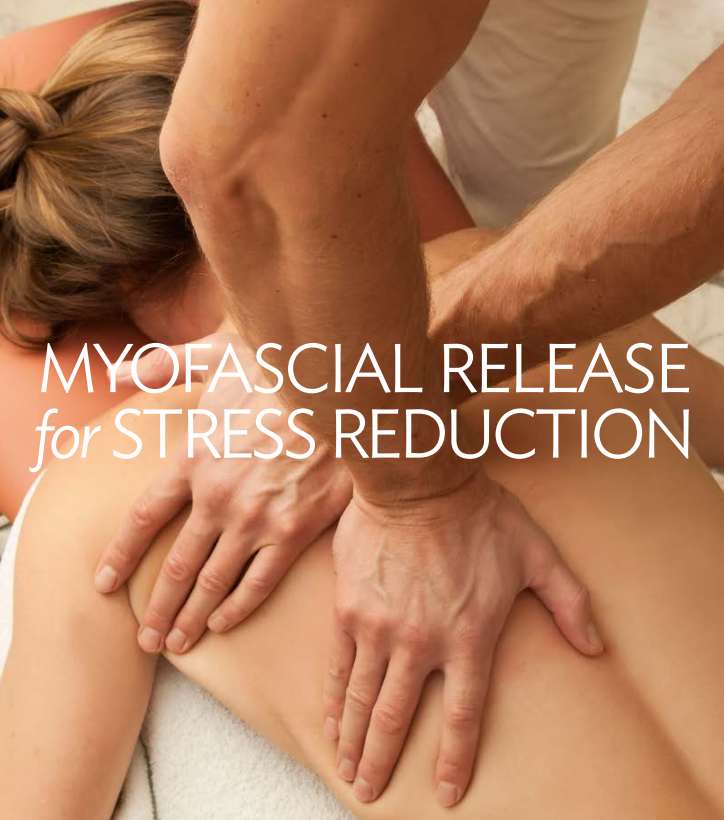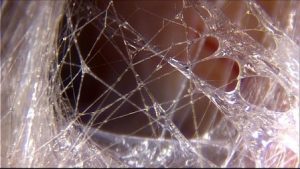
*This is an article from the Summer 2023 issue of Contentment Magazine.
By John F. Barnes, PT
President and CEO of the Myofascial Release Treatment Centers & Seminars
The old adage that time heals all wounds in my experience is not accurate. I have found from over 60 years’ experience as a Physical Therapist that time does not heal all wounds. It buries the trauma deeper and deeper into the fascial system of our body. This has to do with a phenomenon called tissue memory that’s not just in the brain and neurological system but actually lies in every cell.
The Fascia is a specialized system of the body that has an appearance similar to a spider’s web or a knitted sweater. Fascia is very densely woven, covering and interpenetrating every muscle, bone, nerve, artery and vein, as well as, our internal organs including the heart, lungs, brain and spinal cord. The most interesting aspect of the fascial system is that it is not just a system of separate coverings, it is actually one continuous structure that exists from head to toe without interruption. In this way you can begin to see that each part of the entire body is connected to every other part by the fascia, like the yarn in a sweater. Trauma, inflammatory responses, and/or surgical procedures create Myofascial restrictions that can produce tensile pressures of up to approximately 2,000 pounds per square inch on pain sensitive structures that do not show up in many of the standard tests (x-rays, myelograms, CAT scans, electromyography, etc.) A high percentage of people suffering with pain and/or lack of motion may be having fascial problems that are not diagnosed. 
Myofascial Restrictions
Fascia plays an important role in the support and function of our bodies, since it surrounds and attaches to all structures. In the normal healthy state, the fascia is relaxed and wavy in configuration. It has the ability to stretch and move without restriction. When one experiences physical trauma, emotional trauma, scarring, or inflammation, however, the fascia loses its pliability. It becomes tight, restricted, and a source of tension to the rest of the body. Trauma, such as a fall, car accident, whiplash, surgery or just habitual poor posture and repetitive stress injuries has cumulative effects on the body. The changes trauma causes in the fascial system influences comfort and function of our body. Fascial restrictions can exert excessive pressure causing all kinds of symptoms producing pain, headaches or restriction of motion. Fascial restrictions affect our flexibility and stability and are a determining factor in our ability to withstand stress and perform daily activities.
The fascial system connects to every aspect of our body without interruption and acts as a fiberoptic carrying enormous amounts of information in a very short period of time. Myofascial restrictions that result from physical, emotional or surgical trauma can block the information needed for recovery from our conscious mind. Therefore, all forms of traditional therapy and massage focus on the symptomatic complex which is basically the tip of the iceberg. From our experience, fascial restrictions are one of the primary causes for most of the pain, emotional upheaval, and stress in people’s lives. Interesting to note that the research on the fascial system has been done on cadavers. As you know, dead people are brittle and have no consciousness. This is the model of reality that most healthcare professionals learn.
John F. Barnes Myofascial Release 
I have had the opportunity of training over 100,000 physicians and therapists in my approach to myofascial release which I have been teaching for over 50 years. Myofascial Release’s main purpose is to reduce pain, restore motion and reduce stress. There is an increasing body of supportive research and information about this phenomenon.
Fascia is tough tissue with an elastic and muscular component and a collagenous component, unfortunately, this information has not been available in our training as physicians and therapists. Fascial restrictions can generate enormous pressures in the body and brain, and neurological system somewhere up to approximately 2000 pounds per square inch from physical or emotional trauma. The frustrating part is that fascial restrictions, which can begin early in life, can accumulate and do not show in any of the standard testing i.e. X-rays, CAT scans, MRI’s, myelograms, bloodwork, etc. So myofascial restrictions have essentially gone undiagnosed and therefore are not properly treated in therapeutic interventions. Myofascial Release, because it uses gentle, sustained pressure never causes injury and can be highly effective in most people. Because of our success, a lot of copy-cat courses have popped up calling themselves Myofascial Release, but they teach what I call the old form of myofascial release, which uses too much pressure and can actually produce trauma and stress within the body. The principles that I have developed open up the elastic and muscular component, but also the collagenous barrier which other forms of therapy do not address. Within the collagenous barriers lie memories and information that is essential for our physiological functioning and calmness of mind. What I have found is that most forms of manual therapy are performed too quickly. For example, with joint mobilization and manipulation, you are in and out of the system quite quickly, and with massage you are rubbing over or trying to force through the restriction. This does not release the fascial system fully and unfortunately only gives temporary results. 
Myofascial Release properly performed holds at the restricted area for a number of minutes and only around the five-minute period does a number of phenomena occur that contribute to authentic, lasting healing. These phenomena are called the Piezoelectric Effect, followed by Mechanotransduction, coupled with Phase Transition and ultimately Resonance, which is another word for release.
Candace Pert PhD, the renowned researcher, developed the Endorphin Theory many decades ago. In her book, “The Molecules of Emotion” she states that every cell possesses memory, emotions and information. Her research work has focused on the neuropeptide system which is the physical substrate of our emotions and essential information that passes thru the billions of microtubules of the fascial system at enormous speeds. This sensory information then interacts with the brain and nervous system and becomes conscious.
All forms of therapy have to do with our intellectual rational side which I have labeled “channel 5.” Unfortunately, we don’t heal in the channel 5 world from the Myofascial perspective. However, Myofascial Release, in a very safe, efficient, and highly effective way, moves us into what I call our channel 3 consciousness which is our intuitive, instinctual side, otherwise known as the healing zone. Another word for this is our “feeling intelligence” or wisdom, which is vast compared to our intellectual side.

Our experience has shown that the body is capable of self-correction. A missing link in healthcare has been utilizing myofascial release to open up the collagenous barrier of the fascial system. As a result, the flight, fight, or freeze response that too many people have become trapped in, despite all the therapy they have had, creates horrendous stress in their system and pain. Utilizing Myofascial Release releases fascial restrictions, and allows the body to return to its normal homeostatic state.
If you are interested in receiving Myofascial Release for yourself or for referring your clients or patients, go to our website www.myofascialrelease.com where there is a directory to find a Myofascial Release therapist near you.
Myofascial Release is truly the missing link in the reduction of pain, restoration of function and the reduction of stress coupled with your area of expertise.
References
- Davis, Carol M., DPT, EdD, MS, FAPTA. (2016). Integrative Therapies in Rehabilitation: Evidence for Efficacy in Therapy. Slack, Incorporated.
- Fernández-Pérez AM, Peralta-Ramirez MI, Pilat A, Moreno-Lorenzo C, Villaverde-Gutierrez C, Arroyo-Morales M. Can myofascial techniques modify immunological parameters? J Alt Compl Med. 2013;19(1):24-28.
- Guimberteau, Dr. Jean-Claude. (2015). Architecture of Human Living Fascia: Cells and Extracellular Matrix as Revealed by Endoscopy. Handspring, Edinburgh.
- Hammeroff SR. Quantum coherence in microtubules: a neural basis for emergent consciousness. J Consciousness Studies. 1994;1 (91-118)
- Hicks MR, Cao TV, Campbell DH, Standley PR. Mechanical Strain Applied to Human Fibroblasts Differentially Regulates Skeletal Myoblast Differentiation. J Appl Physiol. 2012
- Ingber DE. Cellular mechanotransduction: putting all the pieces together again. FASEB J. 2006; 20(7):811-827
- Katake, K. The Strength for Tension and Bursting of Human Fascia. J Kyoto Pref Med Univ. 1961; 69: 484-488.
- Langevin HM. Connective tissue: a body-wide signaling network? Med Hypotheses. 2006; 66(6):1074-1077
- Meltzer KR, Standley PR. Modeled repetitive motion strain and indirect osteopathic manipulative techniques in regulation of human fibroblast proliferation and interleukin secretion. J Am Osteopath Assoc. 2007 Dec;107(12):527-36.
- Meltzer KR, Cao TV, Shad JF, King H, Stoll ST, Standley PR. In Vitro Modeling of Repetitive Motion Injury and Myofascial Release. J Bdyw Mov Ther. 2010 14(2): 162-171.
- Oschman JL. Energy Medicine: The Scientific Basis. 2nd ed. New York, New York: Elsevier; 2016.
- Oschman JL. Fascia as a body-wide communication system. In: Schleip R, Findley TW, Chaitow L, Huijing PA, eds. Fascia: The Tensional Network of the Human Body: The Science and Clinical Applications in Manual and Movement Therapy. Edinburgh, Scotland: Elsevier; 2012
- Penrose R. Shadows of the Mind: A Search for the Missing Science of Consciousness. Oxford England: Oxford University Press; 1994
- Pert CB. Molecules of Emotion: Why You Feel the Way You Feel. New York, NY: Simon & Schuster; 1997.
- Pischinger A. The Extracellular Matrix and Ground Regulation: Basis for a Holistic Biological Medicine. Heine H, Eibl I, eds. Berkely, CA North: North Atlantic Books; 2007.
ABOUT THE AUTHOR

John F. Barnes, PT, is an international lecturer, author and renown expert in the area of myofascial release. He has been treating patients since 1960 and is the owner, director and chief physical therapist of the “Sanctuary Myofascial Release Treatment Center” in Malvern, Pennsylvania and “Therapy on the Rocks Myofascial Release Treatment Center” in Sedona, Arizona.
In addition to treating patients from around the world, John also manages a successful educational company, Myofascial Release Seminars. During the 1970’s he began developing his Myofascial Release Approach® and teaching his seminars. He has trained over 100,000 therapists and physicians in his highly successful Myofascial Release Approach®.
John F. Barnes, PT is the author of Myofascial Release: The Search for Excellence (Rehabilitation Services Inc., 1990) and Healing Ancient Wounds: The Renegade’s Wisdom (Myofascial Release Treatment Centers & Seminars, 2000). He has been the featured speaker at the American Back Society symposiums for over 25 years. The American Back Society is comprised of neurosurgeons, orthopedic surgeons, psychiatrists, therapists and TMJ specialists whose focus has been the most important advances in healthcare in the last century. John F. Barnes is known as the “Father of Myofascial Release” and was named one of the most influential persons in the therapeutic profession in the last century, in the national Massage Magazine’s featured article titled “Stars of the Century.”
Website: www.myofascialrelease.com
Email: [email protected]
Phone: 1-800-FASCIAL
Contentment Magazine
The dictionary defines “content” as being in a state of peaceful happiness. The AIS magazine is called Contentment because we want all of our guests and members to find contentment in their lives by learning about stress management and finding what works best for each them. Stress is unavoidable, and comes in many shapes and sizes that makes being in a state of peaceful happiness seem like a very lofty goal. But happiness is easy to find once you are able to find ways to manage your stress and keep a healthy perspective when going though difficult times in life. You will always have stress, but stress does not always have you!
